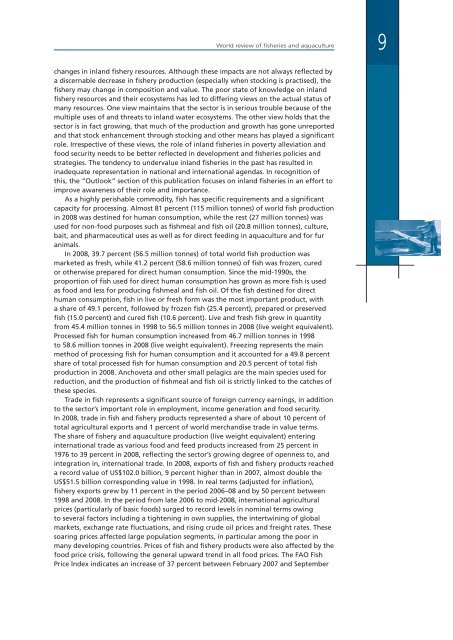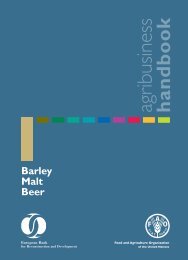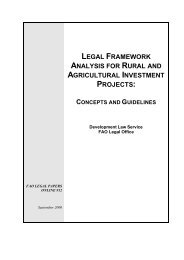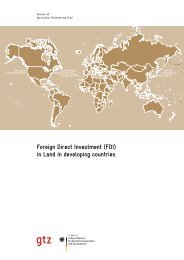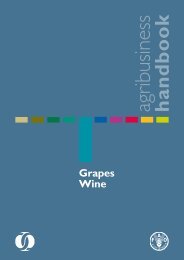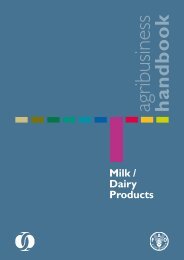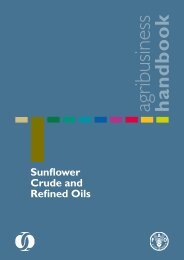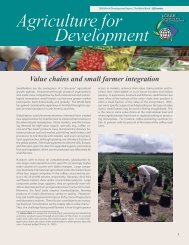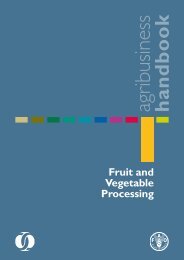The State of World Fisheries and Aquaculture 2010 - FAO
The State of World Fisheries and Aquaculture 2010 - FAO
The State of World Fisheries and Aquaculture 2010 - FAO
You also want an ePaper? Increase the reach of your titles
YUMPU automatically turns print PDFs into web optimized ePapers that Google loves.
<strong>World</strong> review <strong>of</strong> fisheries <strong>and</strong> aquaculture<br />
9<br />
changes in inl<strong>and</strong> fishery resources. Although these impacts are not always reflected by<br />
a discernable decrease in fishery production (especially when stocking is practised), the<br />
fishery may change in composition <strong>and</strong> value. <strong>The</strong> poor state <strong>of</strong> knowledge on inl<strong>and</strong><br />
fishery resources <strong>and</strong> their ecosystems has led to differing views on the actual status <strong>of</strong><br />
many resources. One view maintains that the sector is in serious trouble because <strong>of</strong> the<br />
multiple uses <strong>of</strong> <strong>and</strong> threats to inl<strong>and</strong> water ecosystems. <strong>The</strong> other view holds that the<br />
sector is in fact growing, that much <strong>of</strong> the production <strong>and</strong> growth has gone unreported<br />
<strong>and</strong> that stock enhancement through stocking <strong>and</strong> other means has played a significant<br />
role. Irrespective <strong>of</strong> these views, the role <strong>of</strong> inl<strong>and</strong> fisheries in poverty alleviation <strong>and</strong><br />
food security needs to be better reflected in development <strong>and</strong> fisheries policies <strong>and</strong><br />
strategies. <strong>The</strong> tendency to undervalue inl<strong>and</strong> fisheries in the past has resulted in<br />
inadequate representation in national <strong>and</strong> international agendas. In recognition <strong>of</strong><br />
this, the “Outlook” section <strong>of</strong> this publication focuses on inl<strong>and</strong> fisheries in an effort to<br />
improve awareness <strong>of</strong> their role <strong>and</strong> importance.<br />
As a highly perishable commodity, fish has specific requirements <strong>and</strong> a significant<br />
capacity for processing. Almost 81 percent (115 million tonnes) <strong>of</strong> world fish production<br />
in 2008 was destined for human consumption, while the rest (27 million tonnes) was<br />
used for non-food purposes such as fishmeal <strong>and</strong> fish oil (20.8 million tonnes), culture,<br />
bait, <strong>and</strong> pharmaceutical uses as well as for direct feeding in aquaculture <strong>and</strong> for fur<br />
animals.<br />
In 2008, 39.7 percent (56.5 million tonnes) <strong>of</strong> total world fish production was<br />
marketed as fresh, while 41.2 percent (58.6 million tonnes) <strong>of</strong> fish was frozen, cured<br />
or otherwise prepared for direct human consumption. Since the mid-1990s, the<br />
proportion <strong>of</strong> fish used for direct human consumption has grown as more fish is used<br />
as food <strong>and</strong> less for producing fishmeal <strong>and</strong> fish oil. Of the fish destined for direct<br />
human consumption, fish in live or fresh form was the most important product, with<br />
a share <strong>of</strong> 49.1 percent, followed by frozen fish (25.4 percent), prepared or preserved<br />
fish (15.0 percent) <strong>and</strong> cured fish (10.6 percent). Live <strong>and</strong> fresh fish grew in quantity<br />
from 45.4 million tonnes in 1998 to 56.5 million tonnes in 2008 (live weight equivalent).<br />
Processed fish for human consumption increased from 46.7 million tonnes in 1998<br />
to 58.6 million tonnes in 2008 (live weight equivalent). Freezing represents the main<br />
method <strong>of</strong> processing fish for human consumption <strong>and</strong> it accounted for a 49.8 percent<br />
share <strong>of</strong> total processed fish for human consumption <strong>and</strong> 20.5 percent <strong>of</strong> total fish<br />
production in 2008. Anchoveta <strong>and</strong> other small pelagics are the main species used for<br />
reduction, <strong>and</strong> the production <strong>of</strong> fishmeal <strong>and</strong> fish oil is strictly linked to the catches <strong>of</strong><br />
these species.<br />
Trade in fish represents a significant source <strong>of</strong> foreign currency earnings, in addition<br />
to the sector’s important role in employment, income generation <strong>and</strong> food security.<br />
In 2008, trade in fish <strong>and</strong> fishery products represented a share <strong>of</strong> about 10 percent <strong>of</strong><br />
total agricultural exports <strong>and</strong> 1 percent <strong>of</strong> world merch<strong>and</strong>ise trade in value terms.<br />
<strong>The</strong> share <strong>of</strong> fishery <strong>and</strong> aquaculture production (live weight equivalent) entering<br />
international trade as various food <strong>and</strong> feed products increased from 25 percent in<br />
1976 to 39 percent in 2008, reflecting the sector’s growing degree <strong>of</strong> openness to, <strong>and</strong><br />
integration in, international trade. In 2008, exports <strong>of</strong> fish <strong>and</strong> fishery products reached<br />
a record value <strong>of</strong> US$102.0 billion, 9 percent higher than in 2007, almost double the<br />
US$51.5 billion corresponding value in 1998. In real terms (adjusted for inflation),<br />
fishery exports grew by 11 percent in the period 2006–08 <strong>and</strong> by 50 percent between<br />
1998 <strong>and</strong> 2008. In the period from late 2006 to mid-2008, international agricultural<br />
prices (particularly <strong>of</strong> basic foods) surged to record levels in nominal terms owing<br />
to several factors including a tightening in own supplies, the intertwining <strong>of</strong> global<br />
markets, exchange rate fluctuations, <strong>and</strong> rising crude oil prices <strong>and</strong> freight rates. <strong>The</strong>se<br />
soaring prices affected large population segments, in particular among the poor in<br />
many developing countries. Prices <strong>of</strong> fish <strong>and</strong> fishery products were also affected by the<br />
food price crisis, following the general upward trend in all food prices. <strong>The</strong> <strong>FAO</strong> Fish<br />
Price Index indicates an increase <strong>of</strong> 37 percent between February 2007 <strong>and</strong> September


